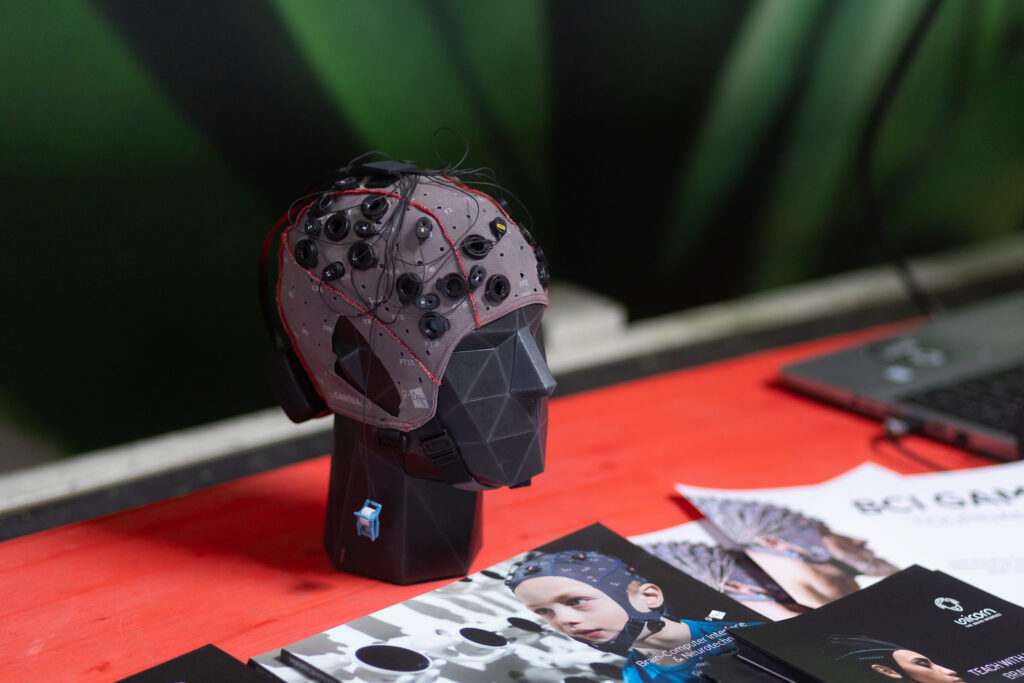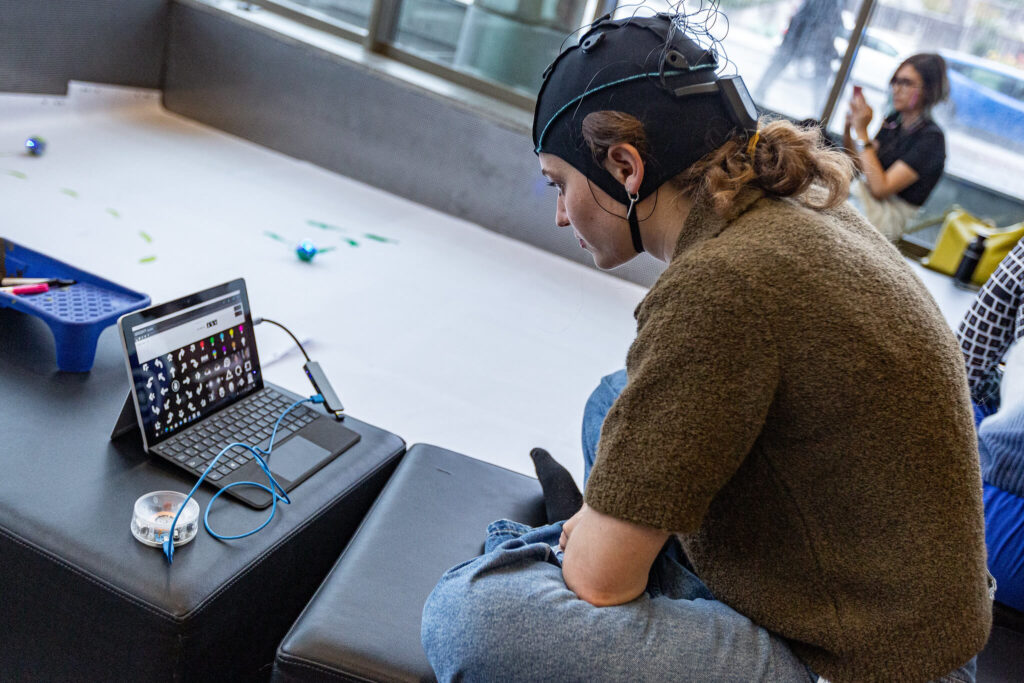From Professor X in X-Men to Eleven in Stranger Things, the power of moving things with our minds has long captured our collective imagination. These are (thankfully) fictional characters. But could real-life telekinesis be closer than we think? Proponents of brain-computer interface (BCI) technology certainly think so. BCIs are devices that create a direct link between our brains and computers, no pesky keyboards or buttons required. This technology gives a new meaning to “mind over matter,” and they’re already starting to see use in medicine. In this article, we’ll explore the tantalizing potential of BCIs—benefits, use cases, and risks.

How Do Brain-Computer Interfaces Work?
At their core, BCIs decode the electrical signals generated by our brains. They then translate them into commands that can be understood by external devices. This process involves several key steps:
Step 1. Signal Acquisition
There are two main types of BCIs. Invasive BCIs require surgery to implant electrodes directly into the brain tissue. This direct contact allows for the most precise and high-resolution recording of brain activity, as they bypass the skull. Invasive BCIs are suitable for fine motor control or complex communication. For example, they can help paralysis patients control robotic limbs and type with their thoughts. However, this type of BCI carries surgical risks, potential long-term side effects, and more ethical concerns.
Non-invasive BCIs don’t require surgery, as they measure brain activity from outside the skull. They’re typically less precise than invasive BCIs but are safer, cheaper, and easier to use. The EEG (Electroencephalogram) headset, which measures electrical activity through the scalp, is the most common form factor. While less powerful than their invasive cousins, non-invasive BCIs will have a much easier path toward broad adoption.
Step 2. Signal Processing
The raw brain signals are then processed and filtered to remove noise and artifacts. This often involves using sophisticated algorithms to identify patterns and features in the data that correspond to specific thoughts or intentions. Here, there’s a lot of synergy with AI, particularly with deep learning.
A fascinating example of AI and deep learning in action is in the development of BCIs that enable individuals to type with their thoughts. The user is asked to imagine writing or typing specific letters and words while their brain activity is recorded. This data is used to train a deep learning model to recognize the unique patterns of neural activity associated with each letter. Once trained, the model can decode brain activity in real time as the user imagines typing.
Step 3. Translation and Output
The processed signals are then translated into commands that can be used to control external devices. For example, a BCI might translate a pattern of brain activity associated with the thought of moving a hand into a command that moves a robotic arm. Or in the previous typing-with-thoughts example, each imagined letter is translated into a corresponding character on a screen.

BCIs in Medicine: Low-Hanging Fruit
Medicine is undoubtedly one of the most significant near-term applications for BCIs. This technology is already starting to help patients with neurological disorders and disabilities. For example, they’re being used in:
Restoring Communication
The BrainGate consortium has developed a BCI system that allows paralysis patients to control a computer cursor or robotic arm with their thoughts. One participant, a woman with amyotrophic lateral sclerosis (ALS), was able to use BrainGate to type and send emails.
Synchron is developing a minimally invasive BCI called the Stentrode. This is implanted through blood vessels and allows patients with severe paralysis to control digital devices with their minds. Stentrode has shown promise in enabling activities like online shopping and texting.
Motor Function Recovery
Neuralink is working on an implantable BCI that aims to restore motor function in individuals with paralysis. Their early demonstrations have shown a monkey playing video games with its mind.
Ekso Bionics has developed experimental exoskeletons that can be controlled by BCIs. This allows individuals with spinal cord injuries to walk again and restore mobility.
Neurological Disorder Treatment
Deep Brain Stimulation (DBS) is an invasive BCI technique that has been used to treat Parkinson’s disease and essential tremor. It involves implanting electrodes in specific brain regions and delivering electrical stimulation to alleviate symptoms.
NeuroPace has developed a BCI system called RNS (Responsive Neurostimulation) that is used to treat epilepsy. The RNS system detects abnormal brain activity and delivers targeted electrical stimulation to prevent seizures.
Pain Management
SPR Therapeutics is developing a non-invasive BCI that uses electrical stimulation to modulate pain signals in the brain. This technology aims to reduce chronic pain in individuals with various conditions.
Sensory Restoration
Second Sight Medical Products (now Vivani Medical) developed the Argus II, a retinal prosthesis. Argus uses a camera and a BCI to provide limited vision to individuals with certain types of blindness. While not a complete restoration of sight, this is still a significant breakthrough in visual prosthetics.

Challenges and Risks of BCIs
While the potential of BCIs is immense, they still face major barriers to adoption.
First, we still need better signal accuracy and reliability. The brain is a complex organ, and decoding its signals with precision remains a daunting task. Current BCIs can be prone to errors and misinterpretations, limiting their real-world effectiveness.
Brain signals can also vary significantly between individuals. In fact, they can even vary within the same person depending on their mental state. This makes it very difficult to develop universally applicable BCI systems.
Invasive procedures also carry unique risks. Implanting electrodes into the brain, as required for some BCIs, risks infection, bleeding, and tissue damage. Also, the long-term effects of having foreign objects in the brain are not yet fully understood.
BCIs also raise profound ethical questions about privacy, autonomy, and the potential for misuse. Who owns the data collected by BCIs? Could BCIs be used to manipulate thoughts or behavior? What if they get hacked? These are just some of the ethical dilemmas that need to be addressed as BCI technology advances.
And of course, there’s the huge public perception challenge. The idea of implanting devices in the brain or wearing headsets that read our thoughts can be unsettling for many people. Overcoming public skepticism will be crucial for the widespread adoption of BCIs.
BCIs and the Race Against AI
With the rise of artificial intelligence (AI), another fascinating perspective has emerged. Some people believe that BCIs could be the key to humanity’s survival and even dominance in a world increasingly shaped by AI.
This line of thought posits that as AI continues to advance at an exponential pace, humans risk being left behind. This is already true for specific areas of cognitive capability and problem-solving. BCIs, with their potential to enhance our brains and augment our abilities, could offer a way for humans to keep pace with AI and even surpass it.
Proponents of this view argue that by integrating BCIs with our brains, we could tap into the power of AI directly. We could leverage its vast knowledge base and computational abilities to augment our own intelligence. This could lead to a symbiotic relationship where humans and AI work together to solve complex problems and create a better future for all.
This perspective is not without its critics. Some worry that enhancing our brains with BCIs could lead to unforeseen consequences, both for individuals and society as a whole. There are also concerns about potential abuse of this technology and the ethics of blurring the lines between human and machine. Whether or not BCIs ultimately prove to be the key to humanity’s triumph over AI, this debate highlights the raw potential of this technology. Will the rewards outweigh the risks?
The Future of Brain-Computer Interfaces
The future of BCIs is a landscape brimming with potential. Ongoing research and development are pushing the boundaries of what’s possible. Here’s how:
Advancements in Signal Acquisition Hardware
Imagine BCIs so small and unobtrusive that they become an indistinguishable part of our everyday lives. Researchers aim to miniaturize BCI hardware, making it more comfortable, portable, and affordable. The ultimate goal is to create devices that we forget are there, perhaps even becoming wearable accessories.
Rigorous Safety and Validation
As BCIs transition from research labs to real-world applications, ensuring their safety is key. Rigorous clinical trials and regulatory frameworks are being developed to validate BCI technology and pave the way for its widespread adoption. This will ensure that BCIs reach those who need them most while upholding the highest standards of safety and efficacy.
Enhanced Reliability and Accuracy
While BCIs have already shown promise, there’s still room for improvement in signal accuracy and reliability. Researchers are exploring new ways to filter out noise and artifacts, refine signal processing algorithms, and personalize BCIs to individual brain patterns. These advancements will make BCIs more robust and dependable, especially in therapeutic applications.
Passive BCIs
One of the most exciting frontiers in BCI research is the development of passive BCIs. Unlike active BCIs, which require users to perform specific mental tasks to control devices, passive BCIs work autonomously in the background. They can continuously monitor brain activity to detect changes in mental state, emotions, or intentions. This could lead to applications like:
- Mental Health Monitoring: Passive BCIs could detect early signs of mental health conditions like depression or anxiety. This would allow timely interventions and personalized treatment.
- Collaborative Robots (“Cobots”): Cobots are robots meant to work alongside humans. BCIs could enable us to control them with our thoughts, gestures, or even emotions. This would create a more intuitive and natural interaction than traditional interfaces like joysticks or keyboards.
- Brain-Powered Safety Systems: Passive BCIs could be integrated into vehicles or other machinery to monitor the operator’s alertness and attention. This could prevent accidents caused by fatigue or distraction.
The possibilities of BCIs are as vast as the human imagination. As this technology continues to evolve, we can anticipate a future where our minds seamlessly interface with machines, unlocking new levels of communication, creativity, and control over our world.